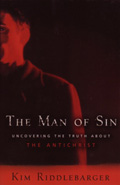
Kim Riddlebarger
Reviewed by: Brian T. Wingard
The Man of Sin: Uncovering the Truth about the Antichrist, by Kim Riddlebarger. Published by Baker Books, 2006. Paperback, 236 pages, list price 15.99. Reviewed by OP missionary Brian T. Wingard.
If one ever believed that amillennialism was a monolithic view of eschatology, Kim Riddlebarger's book is a good antidote to that belief. This reviewer holds to an amillennial position, but he was surprised, to say the least, by the views expressed here.
The author says he wishes to combat the view of the Antichrist that is found in the popular media and even in more serious dispensational theology. This is certainly a laudable goal. However, as one reads further into the book, one is at a loss to know if the chief target is the view of the Antichrist found in dispensationalism or the one in preterism. The readers of this book need to know what the debate actually is. Is it a debate among pre-, post-, and amillennialism, as these views relate to the Antichrist, or is it a defense of futurism against preterism and historicism (competing interpretations of the book of Revelation, which do not correspond to the different millennial views). This question comes to the fore when the author's picture of the Man of Sin is fleshed out.
To explain the Antichrist, the author begins at Genesis 3:15. There he finds both the promise of Christ and the promise of the Antichrist. As the seed of the woman will culminate in the appearance of Jesus Christ, so the seed of the serpent will come to final expression in the appearing of the Man of Sin. It is here that the reviewer's disappointment with the book comes to a head, for the author seems to present a messianic dualism. The meaning of the prefix anti- is subtly changed from its basic meaning of "against" to "reverse" or "opposite." In this view, the Antichrist becomes "the Messiah of Satan," though one would have thought that it was this very view that the author was opposing in the section of the first chapter entitled "The Antichrist in Evangelical Film and Fiction."
However, this use of Genesis 3:15 is contrary to the text. The verse does present us with two competing seeds, but not two competing messiahs. The heel of Christ is there juxtaposed to the head of Satan, not the head of the Antichrist. Also, in making Christ's great opponent the Antichrist, rather than Satan, the importance of the cross, resurrection, and ascension of Christ is diminished, for Christ will not be victorious until the Antichrist is destroyed. This places the decisive battle in the future, not in the past! This flawed exegesis lies behind the central argument of the book and makes it appear to be a brief for futurism that rests upon a questionable foundation.
This book is interesting and may be read with profit. However, the case it makes is not compelling.
November 09, 2025
November 02, 2025
October 26, 2025
October 19, 2025
October 05, 2025
Raising Sexually Faithful Kids and
Parenting Boys and Girls in a Gender-Confused World
September 28, 2025
Calvin’s Ecclesiology: A Study in the History of Doctrine
September 21, 2025
© 2025 The Orthodox Presbyterian Church